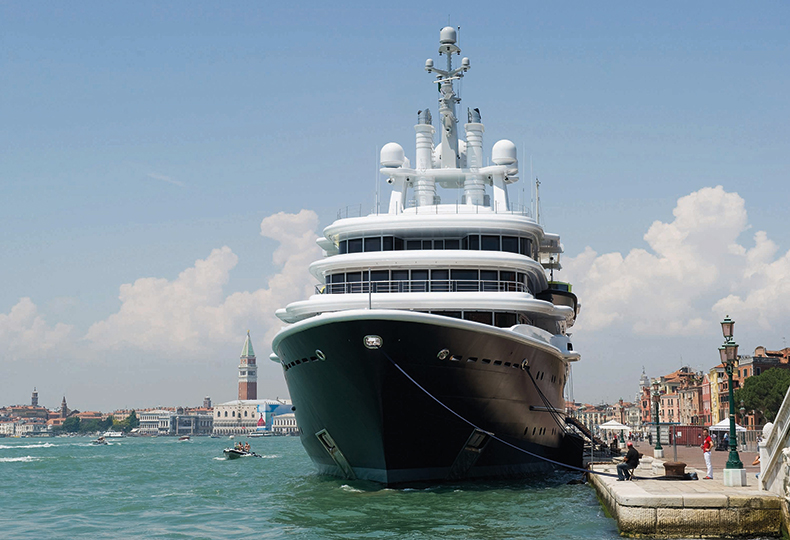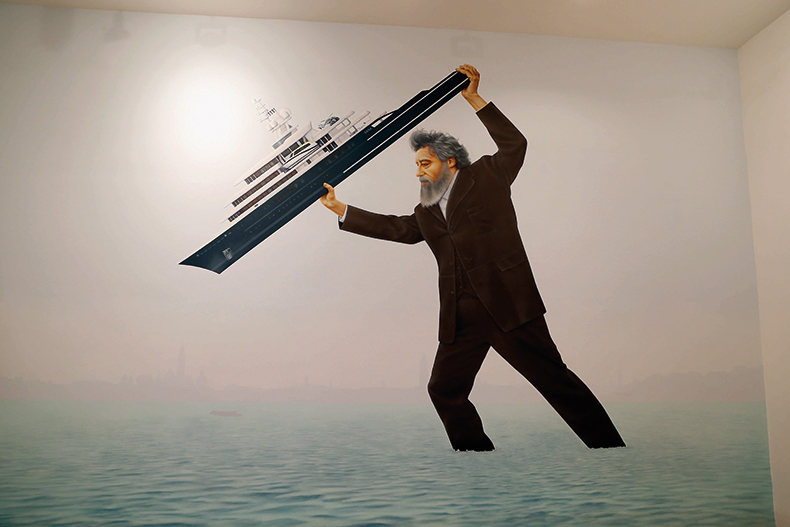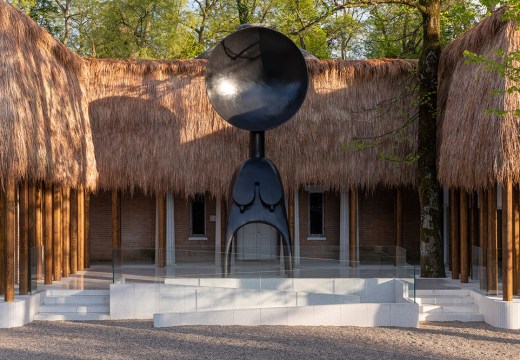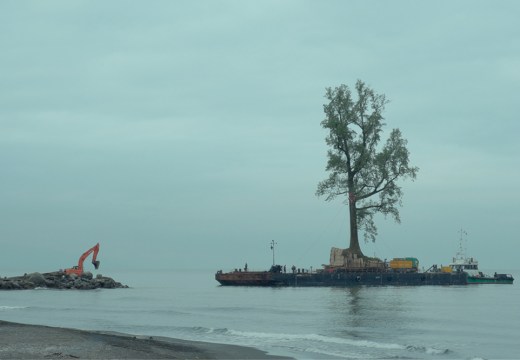From the May 2022 issue of Apollo. Preview and subscribe here.
The preview of the Venice Biennale this year was the most hotly anticipated in living memory, taking place after a three-year gap instead of the usual two because of the Covid-19 pandemic. Apart from artistic director Cecilia Alemani’s main exhibition, ‘The Milk of Dreams’, sprawling across huge spaces in the Giardini and Arsenale, there are more than 100 other national pavilions and major shows. But even in this artistic paradise, reality intrudes. The shuttered Russian pavilion sitting empty is a reminder for visitors walking up and down the Giardini’s main avenue of the bitterly-fought Ukrainian war. There was no sign either of Luna, billionaire art-collector Roman Abramovich’s yacht, which for years has been moored near the Giardini during the Biennale’s preview.

Roman Abramovich’s super-yacht, Luna, moored in Riva Setta Martiri during the Venice Biennale in 2011. Photo: Marco Secchi/Getty Images
Russia’s invasion of Ukraine has forced governments around the world to shine a light on the activities of Abramovich and others – a cadre of Russian billionaires who are alleged to have close ties to Putin. Abramovich is just one of the figures on the rapidly expanding list of Russians, Belarussians, Georgians, Kazakhs and even Ukrainians who have been personally sanctioned by the United Kingdom, European Union or United States.
The situation presents challenges for the top museums, galleries and auction houses. Sotheby’s, Christie’s and Bonhams have cancelled the sales of Russian art in June because the majority of clients for these works are Russian (and because the market for Russian art is small) – and even those who are free to buy may have trouble moving money or their artworks. The Royal Academy, Guggenheim and Tate have severed links with some of their major donors: figures including Petr Aven, Vladimir Potanin and Viktor Vekselberg. Museums and the art trade say they conduct thorough due diligence on their clients – and in the UK the 2020 anti-money laundering regulations brought in an even stricter regime. Critics say this is shutting the door after the horse has bolted. What is often regarded as Russia’s kleptocracy problem is well known, they say, and it is no surprise that some of yesterday’s trusted Russian collectors have become today’s pariahs.
Museums and the art trade have become closely entwined with the super-rich – not just Russians but people from other countries with problematic regimes. In her book, Big Bucks: the Explosion of the Art Market in the 21st century, Georgina Adam remembers a senior auctioneer saying: ‘What I really want to know is how a 1960s Warhol, such as Liz, can go from selling for $2m in 1999 to $24 million in just eight years?’ The answer, in short, is the ballooning number of global billionaires: people wealthy enough to buy art valued at more than $1m on a semi-regular basis.
In 1987, when it started its ‘The World’s Billionaires’ ranking, Forbes counted 140 of them around the world. Then they were mostly in the United States, Japan, West Germany and the UK. That had risen to 470 in 2000 and to around 2,700 in 2021. Now, billionaires are to be found in 70 countries. This growth mirrors the astonishing rise of the art market – especially at the upper end. In 2000 the number of works of art which sold for more than $1m at Sotheby’s, Christie’s and Phillips was 325 (totalling $1.2bn): in 2021 it was 1,340 ($7bn).

Bids are placed on a Vincent Van Gogh painting at Sotheby’s New York In 2019. Photo: Johannes Eisele/AFP via Getty Images
Sotheby’s, Christie’s and Phillips all say that Russian buyers now constitute only a tiny percentage of their businesses, although they all use different metrics to express this. According to Clare McAndrew, founder of Arts Economics, Russian buying at the three auction houses made up around 3 per cent of sales in 2021. This is in contrast to the boom years from 2004 to the financial crash of 2008. Comparable figures for this period are not available, but the auctions of Russian art may provide a guide. In 2003, sales of Russian art at Sotheby’s and Christie’s made less than $20m. By 2007, sales at Sotheby’s, Christie’s and Bonhams (which introduced sales in 2005) had rocketed to more than $300m.
Russians were also big spenders on ‘blue-chip’ works of international art. In 2008 Abramovich was believed to have been the buyer of Lucian Freud’s Benefits Supervisor Sleeping (1995) for $33.6m at Christie’s New York, Francis Bacon’s Triptych (1976) at Sotheby’s a day later, and Alberto Giacometti’s Femme de Venise I (1956) for $14m from Galerie Jan Krugier at Art Basel in Switzerland.
The expansion of the global art market has been matched by the explosion of art museums, art fairs, international biennials and commercial galleries. All this private wealth – Forbes estimates that billionaires are worth about $13 trillion – has brought public benefits. Tate Modern’s £260m extension was largely built thanks to private donors and last year’s spectacularly revamped Bourse de Commerce in Paris was paid for by luxury-goods billionaire François Pinault. Museums across India, China and the Middle East have all been backed by the wealth of billionaires.
The downside of this growth is that not all of the money is squeaky clean. The sanctions against Russia target, among other things, people who, according to Western governments, made money not by free enterprise but by political collusion.
Since 2014 the Economist has run what it calls a ‘crony-capitalism index’ detailing ‘the modern equivalent of the robber barons in late-19th-century America’. Top of the suspect list are billionaires in Russia, Malaysia, Singapore, the Philippines, Ukraine, Mexico, Indonesia, India, Thailand and China (it debates China’s place as either second or tenth on the list depending on definitions). Saudi Arabia, meanwhile, is only missing, it notes, because ‘a purge [by the autocratic monarchy] has meant not a single billionaire from the kingdom has appeared on Forbes’s list since 2017’.
Just because money originates in a ‘crony capitalist’ country doesn’t mean it stays there. The UK is 15th on the list, partly because of the international wealth it has let in. ‘Murky money sloshes around the favoured plutocratic playgrounds of New York, London and Paris,’ the Economist says.
Liam Bailey, head of research at property firm Knight Frank, says London is currently the number one city for inward investment in luxury and business property. He says this is because it has a ‘unique global position, with its legacy of empire and the Common- wealth, its cultural links to Africa, Asia and the broader Anglosphere’ and ‘as a global centre for finance, media, government and education’. In its 2022 Wealth Report, the company says that once they have bought property, the wealthy like to join in a city’s cultural life. Collecting art is cited as the ‘top passion investment’, while philanthropy and environmental and social concerns are ‘key investment drivers’.
The upside of all this money flooding in has been a cultural boom for London since the 1990s. Few now remember when ‘the Tate’ just meant the gallery on Millbank, when there was no Frieze Art Fair and when you could count the number of contemporary art galleries on two hands. Now the boards of museums such as the Tate and Serpentine read like an international Who’s Who of the rich and powerful. In 2019 a report by Arts Council England revealed that wealthy individuals gave £234m in 2017/18 – much of it to museums in London.
The downside is that London has attracted an increasingly dubious reputation for letting anyone in. In March the New York Times was running spoof videos with titles such as ‘Welcome to Londonograd, Where Kleptocrats Wash Their Money Clean’. Some journalists and activists are pointing fingers more directly at the art world, saying museums and the trade are not being thorough enough, allowing the rich to indulge in the time-honoured practice of ‘artwashing’.
At the Venice Biennale in 2013 artist Jeremy Deller painted a mural on the walls of the British Pavilion showing the socialist and reformer William Morris as Poseidon, throwing Abramovich’s Luna into the Venetian lagoon. The work wasn’t particularly about Russians, he said, but the fact that he disliked the super-rich, gas-guzzling cars and yachts and the hierarchies of art-world power on full display at the preview of the Biennale.

Jeremy Deller’s We sit starving amidst our gold, on view at the Venice Biennale in 2013. Photo: Bertrand Rindoff Petroff/Getty Images
Some will say it was ever thus: the ‘robber barons’ – the Carnegies, the Fricks and the Vanderbilts endowed New York’s greatest museums. But we live in shifting times. The Russian invasion is shaming governments into action: the UK government is dusting down the economic crimes bill and has axed the ‘golden visa’ scheme, in the United States, Congress is debating tighter anti-money-laundering laws. It may look less kindly on the special pleading of museums and (to a lesser extent) of the art trade’ for public subsidies and preferential tax treatment because of the supposedly unique social value of art.
Meanwhile, new forms of fast and rough justice are being dealt out by increasingly emboldened activists. It took only two or three years for members of the Sackler family with a stake in Purdue Pharma to be defenestrated from the world’s top museums: much less for military supplier Warren Kanders to be ousted from the board of the prestigious Whitney Museum. Using visually striking actions and social media, groups such as Decolonize This Place, P.A.I.N and Strike MoMA have unseated donors that have attracted their ire. The top end of the art world tends to be conservative on ethical matters and stick to letter of the law. It may have to change that stance – before a combination of activism, governments and war forces it to.
Additional research by Tom Forwood, Critical Edge.
From the May 2022 issue of Apollo. Preview and subscribe here.
Unlimited access from just $16 every 3 months
Subscribe to get unlimited and exclusive access to the top art stories, interviews and exhibition reviews.














![Masterpiece [Re]discovery 2022. Photo: Ben Fisher Photography, courtesy of Masterpiece London](http://www.apollo-magazine.com/wp-content/uploads/2022/07/MPL2022_4263.jpg)
It’s time for the government of London to return to its rightful home